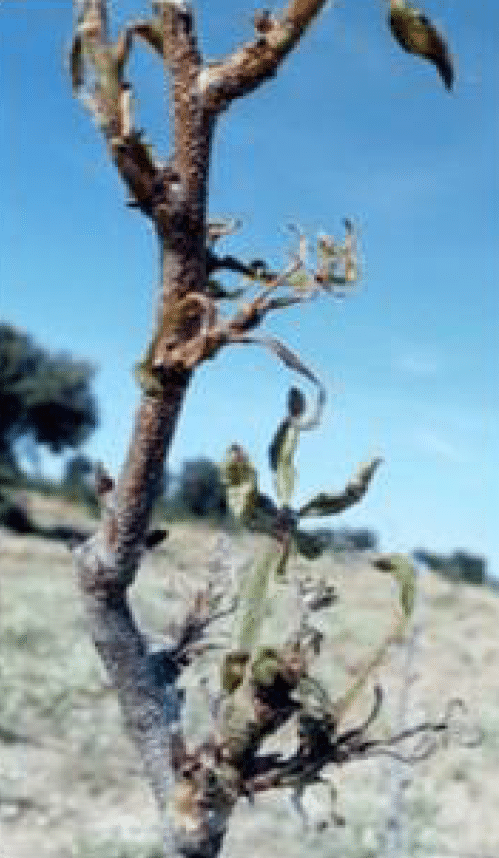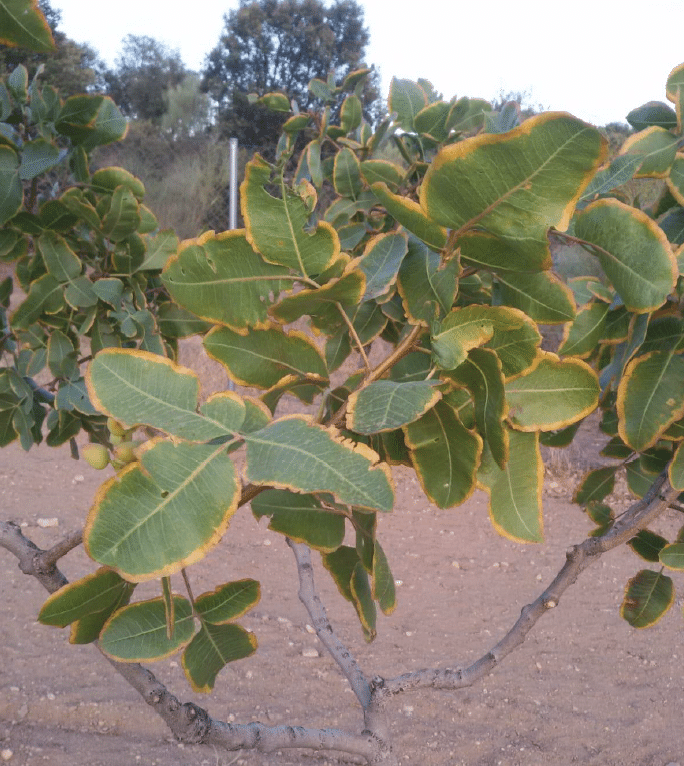Start » Do you know the importance of boron in pistachio cultivation?
Do you know the importance of boron in pistachio cultivation?
Boron participates in the formation of cell walls, cell division, sugar transport, flowering and fruiting. However, many soils are deficient in this micronutrient, which can negatively affect the yield and quality of production.
In this article we explain how a lack of boron affects crops, especially pistachios, and how you can correct this deficiency with adequate fertilization.
Symptoms of lack of boron in crops
Lack of boron It mainly manifests itself in the growth areas of plants, such as shoots, young leaves and fruits. This is because boron deficiency, in principle, affects the reproductive process more severely than vegetative growth. Hormone synthesis is altered, pollen germination decreases and the pollen tube grows with malformations that prevent it from reaching the embryo sac.
Some of the most common symptoms are:
- Stunted growth and deformation of the shoots.
- Chlorosis and necrosis of the youngest leaves, which may fall.
- Reduction in the number and size of flowers, as well as the setting and development of the fruits.
- Appearance of cracked fruits, deformed or with dark spots.
- Dieback of the branches.
The pistachio tree has exceptionally high boron needs. This is why, in the case of pistachio cultivation, a lack of boron can cause a decrease in the yield and quality of the fruits, as well as a greater susceptibility to fungal diseases. Besides, Boron is important for the formation of the endocarp or fruit shell, which should be as hard as possible to protect the pistachio.
Symptoms of boron deficiency in pistachio
Mild deficiency:
- Minor deficiencies cause a high percentage of empty fruits (whites).
- They increase the percentage of closed fruits and reduce both production in kg/ha and their economic value.

The percentage of empty fruits is a varietal characteristic. In the variety Kerman A percentage of empty fruits of up to 10 % is considered normal.
Severe deficiency:
The severe deficiencies They also cause deformation in young leaves.: leaves with edges curled inwards, thick, with dents, with a predominance of leaves with a single leaflet.
In addition to leaf symptoms, there is a reduction in terminal growth, which means that many shoots end up dying. This can end up causing the complete death of some of the main branches, giving the sensation that the tree wants to grow, but cannot.
Causes of lack of boron in crops
The availability of boron in the soil depends on several factors, such as pH, organic matter, texture, humidity and interaction with other nutrients. Some of the most frequent causes of a lack of boron in crops are:
- Soils with alkaline or very acidic pH, which limit the solubility and mobility of boron.
- Soils with low organic matter or high calcium or magnesium content, which can block or compete with boron.
- Soils with a sandy texture or poor drainage, which favor the washing or leaching of boron.
- Adverse weather conditions, such as drought or high temperatures, which reduce root activity and boron absorption.
How to correct a lack of boron in crops
To correct the lack of boron in crops it is necessary to carry out specific fertilization with products that contain this micronutrient. There are different ways and times to apply boron, depending on the type of crop and the degree of deficiency.
Correction of the deficiency is usually achieved using boric acid and boron salts applied to the plants, in the soil, or both. Commercial products contain highly water-soluble boron in concentrations that typically vary between 10 % and 20 %. Processed boron minerals are also marketed that can be used in organic farming; their boron concentration can be similar and their solubility is usually lower.
Fertilization with boron can be carried out both foliarly and radicularly. The foliar route is faster and more effective for correcting specific or moderate deficiencies, while the root route is more suitable for preventing or correcting severe or chronic deficiencies.
The dose and frequency of boron application will depend on the nutritional status of the crop, the type of product used and the environmental conditions. It is important not to exceed the amount of boron applied, as it can cause toxicity or phytotoxicity in plants.

In the case of pistachio cultivation, It is recommended to carry out fertilization with boron both in pre-flowering and post-harvest.. The recommended dose is 0.5 to 1 kg/ha of boron by foliar application and 2 to 4 kg/ha by root application.
Boron toxicity
As has been mentioned, the range of concentrations that separates sufficiency from toxicity is relatively narrow for boron. Therefore, when corrections are made for this micronutrient, it is necessary to be precise with the doses used and meticulous with the form of application.
Toxicity problems may appear in pistachio if concentrations of 400 ppm in the leaf are exceeded.
Conclusion
Boron is an essential micronutrient for the development of crops, especially for fruit trees and nuts, such as pistachio.
In the case of pistachio cultivation, boron deficiency can negatively affect the production and quality of the fruit. The pistachio is a very resistant tree that adapts to extreme climatic conditions and poor or saline soils, but needs an adequate level of boron to ensure good pollination, fruit setting and ripening. In addition, boron helps prevent fungal diseases that can attack the pistachio tree.
Pistachio cultivation is a profitable and sustainable option for many farmers seeking to diversify their farms. However, it requires proper management of the soil, irrigation, fertilization and grafting to obtain optimal production. Boron is one of the factors that influence the success of pistachio cultivation and should not be neglected.
Sources:
Other entries from our blog:
Pistachios as a super food, benefits of including them in the diet and recipe.
Protect your plantation from “Clytra” or “Galeruca” now and minimize damage.
Pistachio prices from the Talavera table.
Background fertilization in the cultivation of the pistachio tree
Pruning the pistachio tree: a key aspect in the cultivation and growth of the plant.
